Indian Guessing Games
by Alice C. Fletcher
V. I-Ou'-tin
INTRODUCTORY NOTE.—This game belongs to the class of guessing games. The form here presented is adapted from the game as played by the Omaha, Otoe, Ponca and Pawnee tribes, among whom it is a favorite.
Properties.—A standard, or the camp flagstaff can be used; a blanket or rug; three official scarfs, one blue, one green, one white; two wands, one decorated with blue and the other with green; eight tally-rods, ornamented at one end with red tassels; two small balls of a light, soft material, hair or wool; a drum; six decorated drum-sticks; rosettes of blue and of green; strips of blue and green paper.
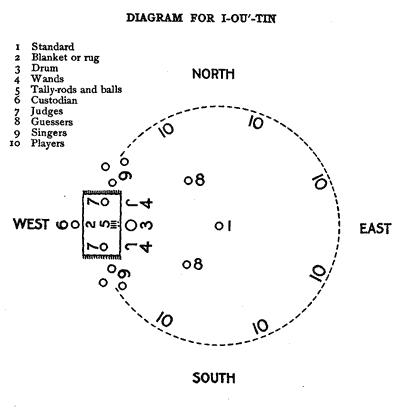
Directions.—A fairly level open space large enough for a circle of from twenty to thirty feet in diameter is marked upon the ground, in the center of which the standard is planted. Directly west and on a line with the standard the blanket or rug is spread. In front of the rug and on a line with the standard the drum is set. At a little distance on each side of the drum the two wands are thrust in the ground, the one decorated with blue to the north, the one with green to the south. On the rug back of the drum the eight tally-rods are laid in a bunch, with the butts of the rods toward the east. At the butts of the rods are placed the two little balls.
The players draw lots as to which side they are to belong. This is done by putting the green and blue strips of paper in a receptacle and each one drawing a strip. Those who draw blue belong to the north side; those who draw green, to the south side. Each player must then fasten a rosette, of the color of the side to which he or she belongs, on the shoulder; those who belong to the north side must put the blue rosette on the right shoulder, and those who belong to the south side must put the green rosette on the left shoulder.
Officers.—Two Judges; a Custodian; two Guessers; six Singers.
The players on the north side choose from among their number one who is to be their Judge; the players on the south side choose one for their Judge. It is the duty of the Judges to select the Custodian, the six Singers, the two Guessers; to preserve order, decide when there are disputes, and to lead in the opening ceremony.
The Custodian has charge of all the properties, must place them as directed, move the drum from side to side, and at the close of the game gather all the articles required for the game and put them in a place of safe keeping for use at another time. The Custodian wears the official white scarf tied about the waist. This officer does not wear any rosette, as the Custodian does not belong to either side but to all who take part in the game.
The Judge on the north side must wear the blue official scarf. This is crossed over the breast from the right shoulder, on which is the blue rosette, to the waist on the left side, where it is tied. The Judge on the south side wears the green official scarf. This is crossed over the breast from the left shoulder, where is the green rosette, to the waist at the right side, where it is tied.
The six Singers, three for each side, sit in an open group on the ground near the ends of the rug, those wearing blue rosettes on the north and those wearing green rosettes on the south side. The players take their seats on the ground on the line of the circle, those wearing blue rosettes on the north half, those wearing green rosettes on the south half of the circle.
When all are in their places the Custodian leads the two Judges to the rug, on which they are to sit a little back of the wands—blue to the North, green to the South. The Custodian then takes up the tally-rods, gives four to each of the Judges and retires to stand back of the rug, behind the Judges, ready for duty.
Up to this moment laughing and talking goes on among the players, but as the Custodian divides the tally-rods and hands them to the Judges instant silence falls on all present.
The Opening Ceremony
The two Judges rise in their places. The north side Judge holds the four tally-rods in his right hand, the south side Judge holds the four tally-rods in his left hand; the two then walk abreast to the standard. There they face the North, move forward a few steps, pause, and each Judge holds up his tally-rods to the North, while all the players on both sides of the circle sing the following song:
Song
1
Hail! O North! Thy wind send
To blow care away,
To bring joy to-day;
Makes Eyes keen,
Make Hands swift for play.
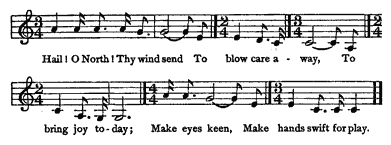
At the close of the stanza the two Judges lower their tally-rods, turn, walk toward the East, pause, then elevate their tally-rods, and all the players sing the second stanza.
2
Hail! O East! Thy wind send
To blow care away,
To bring joy to-day;
Makes Eyes keen,
Make Hands swift for play.
At the close of the stanza the two Judges lower their tally-rods, turn, walk toward the South, pause, again elevate their tally-rods, while all the players sing the third stanza.
3
Hail! O South! Thy wind send
To blow care away,
To bring joy to-day;
Make Eyes keen,
Make Hands swift for play.
At the close of this stanza the two Judges lower their tally-rods, turn, walk toward the West, pause, once more elevate their tally-rods, and all the players join in singing the fourth stanza.
4
Hail! O West! Thy wind send
To blow care away,
To bring joy to-day;
Make Eyes keen,
Make Hands swift for play.
At the close of the song the Judges lower their tally-rods and walk to the rug, where they take their appointed seats behind the respective wands. They then lay all the tally-rods on the space between them.
The Contest
A contest now takes place between the two persons chosen by the Judges to be the two Guessers, one for each side, to decide which shall begin the game. The Judge for the north side calls the name of the person chosen to be the Guesser for that side and the Custodian escorts him to his place within the circle. The Judge for the south side calls the name of the person chosen to be Guesser for that side, and the Custodian escorts him to his place within the circle. The Custodian then gives to each the wand belonging to his side and also one of the small balls.
The Guesser from the north side hides his ball in one of his hands, shifting it behind his back, then he holds out both hands in front of him with all the fingers closed except the index finger, which is extended as if pointing to the other Guesser. Both hands and forearms must be rhythmically moved up and down. The south side Guesser watches for a moment and then points with his wand to the hand he thinks has the ball. As soon as he points to a hand, it must be immediately opened, palm upward. Should the ball be in the other hand, it must be shown to be lying there. If the guess was correct, the ball being in the hand pointed at, it counts one. Three correct guesses must be made by one of the Guessers in order to secure for his side the right to open the game. In this contest the Guessers must alternate, first the north side Guesser, then the south side Guesser, and so on until one of the Guessers has won three correct guesses. That decides it. His side is to hide the ball and the other side's Guesser is to do the guessing.
The Game
The Custodian takes the drum from its position in front of the rug, carries it to the side of the successful Guesser and sets it before the three Singers who are to lead in the singing of the song belonging to that side of the circle of players. Every one on that side must sing the song as they hide the balls. Only those on the side that is hiding the balls sing. They can only sing the song that belongs to their side.
Song For the North Side
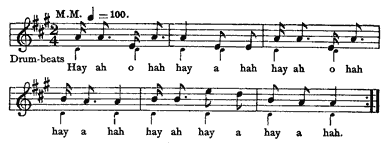
SONG FOR THE SOUTH SIDE
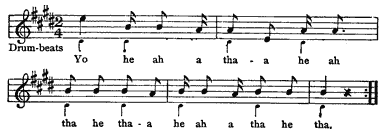
There are no words for either of these songs. The vocables given are those used with these songs when the Indians sing them as they hide the balls.
The Custodian takes the two balls from the Guessers and hands them to two persons designated by the Guesser who has won the right for that side to begin. The two persons designated must be two who are sitting together. They each take a ball, and they must hide the balls in the same manner as did the Guessers during the contest. The fingers of the hands are closed, all but the index finger, which is extended as if pointing. The hands and arms move up and down and also from one side to the other; all of these movements must be in exact time to the song and the drum-beats. These swaying, rhythmic movements are pleasing to the eye and add to the enjoyment of the game. While the two persons having the balls are hiding them, swaying their hands and arms, the Guesser, who is of the opposite side, is watching intently the hands of the players. When he is ready to make a guess he points his wand to where he thinks the balls are—directly in front, if he suspects the balls to be in the two inside hands. If he thinks the balls are in the two outside hands, he points his wand to one of the hands and extends his empty hand toward the other; in that case the Guesser stands with both of his arms extended. As soon as the Guesser points with his wand, the hands indicated must be at once opened, palms upward, so that all can see whether the guess is right or wrong.
Every correct guess counts one for the side of the Guesser. As soon as a correct guess is made, the Judge for that side takes up one of the tally-rods and lays it toward his side; this shows that a point has been won for that side. If the guess is wrong, the Judge for the other side takes up one of the tally-rods and lays it over on his side. The other side has lost one, while his side has gained by the other's loss.
To win a sweep, all the eight tally-rods must be gained by one side. Three sweeps by a side gives that side the game.
Whenever a sweep is made the balls are handed over to the Custodian. The two Judges rise, go to the standard, stand there, one facing North (his side), the other the South (his side). The two Guessers go to the standard, stand there, one facing East, the other West. All the winning side rise, go toward the standard and form a circle around it. There they sing the Victory Song.
Victory Song
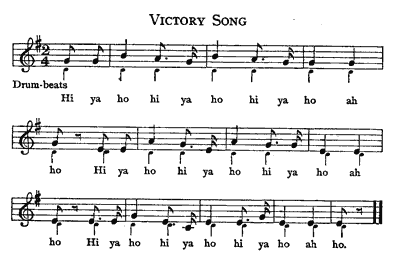
As they sing they sway their arms as though hiding the balls, and dance to the rhythm of the song. Four times they dance around the standard and sing the Victory Song. All movements must be in time with the song. At the close of the fourth circuit of the standard, all return to their appointed places and the game is resumed.
The Custodian takes up the drum, carries it to the side that has just danced and sets it before the three Singers of that side. The Guesser, who is of the opposite side, designates the two who are to hide the balls and the game proceeds as described above.
Whenever a side that has been hiding the balls fails three times to elude the Guesser, then the Custodian takes the drum from that side and carries it to the other side of the circle, puts it before the Singers and gives the balls as directed. Sometimes there are disputes as to these transfers and as to the points lost; three must be lost to secure a transfer. It then becomes the duty of the Judges to decide.
With every transfer of the drum the song changes. The balls and the right to sing go together, but the song belonging to one side must not be sung by the other side. The songs are not interchangeable.
This game is provocative of fun and merriment as well as dexterity of hand and quickness of vision. It also presents a very pretty spectacle. It is greatly enjoyed by Indian men, women and children. It has also found favor with merrymakers of our own race.